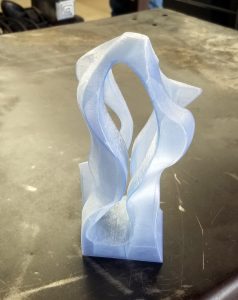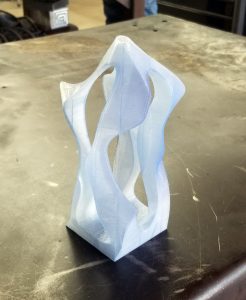 One of the important ways I use 3D printing is to create maquettes, or models, of sculptures.
One of the important ways I use 3D printing is to create maquettes, or models, of sculptures.
It’s one thing to design a sculpture in CAD and put the image into a photograph of a location, something I do often.
It’s another to convert the file into a format that lets me cut metal on my CNC plasma metal cutting table to create an outdoor sculpture. That’s something I do frequently, most recently with my sound sculpture Belfry.
As valuable as those abilities are, though, I sometimes use 3D printing to actually create a small maquette …
 I might use the maquette to show a potential patron, but the way I use it most is to get a really good feel for a sculpture, what I call proof of concept.
I might use the maquette to show a potential patron, but the way I use it most is to get a really good feel for a sculpture, what I call proof of concept.
Yes, I can “see” a sculpture in a CAD drawing since I can rotate it every possible way, but that doesn’t tell me, for instance, whether the sculpture will actually stand up (sometimes my designs don’t – until I tweak them). Or what it REALLY looks like.
Recently I was playing with a wild design for a sound sculpture. I designed it in CAD, but wanted to know how it would look and if it’s even possible to create in metal.
I 3D printed the design on my Cerberus 3D 400 3D printer, which is right by my desk.
The first time, it wouldn’t even 3D print because the design was just too narrow in places.
In take 2, it 3D printed just fine – that’s the image you’re seeing in this post from a couple of different angles.
I took the maquette down to my metal-working studio so we can think about how to actually make this crazy shape – I’m not entirely sure I know how, but then, that’s part of the challenge ….
Meanwhile, I’m thinking about 3D printing the sculpture about 4 feet tall on my 8-foot-tall Cerberus 3D Gigante 3D printer and then hanging a metal bell in it. That would be a first for me, and maybe for anyone, because who would be crazy enough to try that ….
